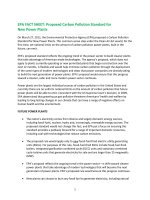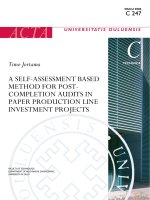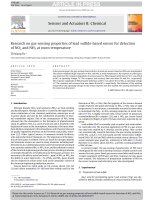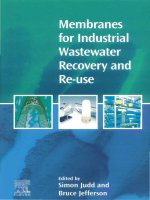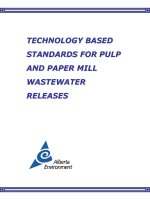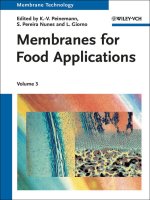carbon based membranes for separation processes
Bạn đang xem bản rút gọn của tài liệu. Xem và tải ngay bản đầy đủ của tài liệu tại đây (15.66 MB, 341 trang )
Carbon-based Membranes for Separation Processes
Ahmad Fauzi Ismail • Dipak Rana
Takeshi Matsuura • Henry C. Foley
Carbon-based Membranes
for Separation Processes
1 3
ISBN 978-0-387-78990-3 e-ISBN 978-0-387-78991-0
DOI 10.1007/978-0-387-78991-0
Springer New York Dordrecht Heidelberg London
Library of Congress Control Number: 2011930411
© Springer Science+Business Media, LLC 2011
All rights reserved. This work may not be translated or copied in whole or in part without the written
permission of the publisher (Springer Science+Business Media, LLC, 233 Spring Street, New York, NY
10013, USA), except for brief excerpts in connection with reviews or scholarly analysis. Use in connec-
tion with any form of information storage and retrieval, electronic adaptation, computer software, or by
similar or dissimilar methodology now known or hereafter developed is forbidden.
The use in this publication of trade names, trademarks, service marks, and similar terms, even if they are
not identified as such, is not to be taken as an expression of opinion as to whether or not they are subject
to proprietary rights.
Printed on acid-free paper
Springer is part of Springer Science+Business Media (www.springer.com)
Ahmad Fauzi Ismail
Advanced Membrane Technology Research
Centre (AMTEC)
Materials and Manufacturing Research
Alliance
University Teknologi Malaysia, 81310,
Skudai, Johor
Malaysia
,
Dipak Rana
Department of Chemical and Biological
Engineering
University of Ottawa
161 Louis Pasteur, Ottawa, Ont. K1N 6N5
Canada
Takeshi Matsuura
Department of Chemical and Biological
Engineering
University of Ottawa
161 Louis Pasteur, Ottawa, Ont. K1N 6N5
Canada
,
Henry C. Foley
Department of Chemical Engineering
The Pennsylvania State University
University Park, PA 16802
USA
v
Foreword
Industrial culture has brought with it magnificent improvements in human health
and well being over the last two centuries. At the same time, these advances in the
human condition have come at a cost. All too often in the past, the overall impact of
an industrial process or product was not fully accounted for; waste and by-products
were considered to be merely zero cost disposables. Profit margins thus were ap-
parently higher than we know in hindsight that they should have been. Whether it
was the eighteenth century mill making wool and pouring waste sulfuric acid into a
river or the twentieth century coal power plant emitting megatons of carbon dioxide
as well as lesser amounts of sulfur and mercury, the real overall costs of production,
which must include the environmental impact (or remediation) and public health ef-
fects, were not taken into account. Thus the waste product problems were not con-
sidered to be important, indeed, for a long time they were not considered problems.
At this juncture, early in the twenty-first century, much has changed. We now
think in terms of process and product life cycles and take into account the full
cradle-to-grave costs of production. But even more, we know that as human popu-
lations grow over the next 50–100 years, enormous pressure will be placed upon
all our systems of production, delivery and consumption. Carbon dioxide in the
atmosphere is leading to slow but sure global warming with unknown consequenc-
es. Fresh, clean water will become an increasingly difficult commodity to supply
cheaply to large segments of the population. Energy needs will only rise with time
as developing nations emerge as first world industrial powers. So what has this to
do with carbon membranes the reader may ask? Simply put, many of the most press-
ing technological problems that we face will require solutions that involve energy
efficient separations and carbon membranes will provide the solutions that we seek.
Carbon membranes are still in their infancy as a technology, yet the promise they
hold is enormous. Already we know that nanoporous (0.5–1.0 nm average pore size)
carbon membranes show an especially high affinity for carbon dioxide transport,
a property that will undoubtedly be of utility in carbon capture and sequestration.
They are robust enough to withstand use in aqueous media and at either high or low
pH. When engineered with mesopores (1.0–3.0 nm), they can be used to provide
ultrafiltration of water and other process fluids. In combination with catalysts, they
are able to combine reaction and separation, thereby providing a viable means to
vivi
selectively open the reaction zone and thereby overcoming equilibrium limitations
of the closed system. Carbon membranes have been shown to be useful in a spec-
trum of separations as important and, yet, as delicate as, for example, the separation
of oxygen and nitrogen. In other instances they have been shown to be compatible
with blood, can be used to separate proteins and may offer opportunities for bio-
medical advances. When placed on ceramic or metallic supports, they are able to
withstand high pressures.
If all this is known, then what is left to do? The fact is that most of these demon-
strations have been at the laboratory level and not much beyond that level. Prepara-
tion of these materials is still an art and not a science. The science begins once a use-
ful membrane has been prepared in the lab; prior to that point, despite much effort,
the steps of preparation remain art. Can this be overcome? Certainly it can be. Simi-
larly, it is clear that being able to manufacture materials readily, reproducibly and
at low cost, remains a barrier to adoption and application.Then there is the science
associated with the synthesis of the pore structures. Still too little is known about the
details of the pore structure in many carbon membranes, and this has tended to limit
the science that seeks to understand the mechanisms of separation—especially na-
noscale kinetic separations. Eventually, synthesis of regular pore structures must be
the goal, so that we can have carbon membranes tailored for each application with
pore structures having optimal orientation for regular transport and low tortuosity,
with pores that are sized for the separation to be done and on support media that
lend themselves to ready incorporation into a module.
To get to this point with carbon membranes will take more dedicated research,
the development of new ideas and with luck a few breakthroughs in synthesis and
preparation. The present volume is a terrific starting point for the scientist or engi-
neer who is embarking upon research in the area. Collected in one place for the first
time is all that one needs to know to synthesize and test carbon membranes. The
time saving offered by the collection of information into this volume is enormous
and will prove to be useful not just for one newly entering the field but for the sea-
soned researcher as well.
State College, PA Henry C. Foley
Foreword
vii
Preface
The concept of carbon membrane is not necessarily novel. Ash et al. compressed
nonporous graphite carbon into a plug and called it carbon membrane in early sev-
enties. The practical usefulness of carbon membrane was however realized in the
beginning of eighties for the first time by the work of Koresh and Soffer who pyro-
lyzed many thermosetting polymers to produce carbon molecular sieve membranes.
Since then attempts have been made to use carbon membranes for gas separation,
nanofiltration and other membrane separation processes.
It was the realization that there were performance limits in polymeric membranes
in gas separation which prompted research on carbon membrane. In 1991 Robeson
set upper bounds in the selectivity-permeability plots of several gas-pairs by com-
piling experimental data for a large number of polymeric materials. Although the
boundary lines have been shifted to the desirable direction after nearly 20 years’
research efforts, the achievement has not yet been truly spectacular. Attention of
membrane research community was then focussed on inorganic materials, such as
silica, zeolite and carbon, which exhibited molecular sieving properties. Remark-
able improvements have been made in terms of the selectivity-permeability plot
but the exploitation of these materials for the practical application remains under-
achieved primarily due to their poor processibility.
In order to combine the superb molecular sieving effects of inorganic materi-
als and the desirable mechanical and processing properties of polymers consider-
able efforts have been made recently to fabricate composite membranes, also called
mixed matrix membranes (MMMs), in which inorganic particles are incorporated
in host polymeric membranes. With respect to carbon material, attempts to fabri-
cate MMMs were further encouraged by the recent progress in nano-technology in
general and carbon nano-tubes in particular. Using nano-sized particles instead of
micro-sized particles, the compatibility between the carbon particle and the host
polymeric membrane seems to be enhanced. Moreover, the mass transport through
the nano-tubes is remarkably different from the micro- and macro-sized materials,
as evidenced by the recent discovery of carbon nano-tube membrane for seawater
desalination by reverse osmosis.
viiiviii
The authors intend to make a historic overview of carbon-related membranes in
this book. It will cover the development of carbon related membranes and mem-
brane modules from its onset to the latest research on carbon mixed matrix mem-
branes. After the review of the progress in the field, they also intend to show the
future direction of R&D.
Chapter 1 is the introduction of the book. The general historic overview of the
carbon and carbon-related membranes is made in this chapter.
Chapters 2–7 are dedicated to carbon membranes. A comprehensive literature
review on carbon membrane transport, carbon membrane and carbon membrane
module preparation is made in these chapters.
In Chap. 2, the unique feature of carbon membrane transport is briefly outlined.
Chapter 3 is for the carbon membrane configuration. Currently, all flat sheet,
tubular, capillary and hollow fiber carbon membranes are available at least for labo-
ratory scale experiments. Their merits and demerits are discussed in this chapter.
Chapter 4 is the most comprehensive chapter of the book on the carbon mem-
brane preparation. In this chapter selection of the polymeric precursor membrane,
preparation of polymeric membrane, pre-treatment before pyrolysis, pyrolysis and
membrane post-treatment are dealt with. Furthermore, the membrane preparation
method is described in this chapter as much in detail as possible.
Chapter 5 is for membrane testing. Similar to other inorganic membranes, some
of carbon membranes are less flexible than polymeric membranes. This should be
taken in consideration in the design of the laboratory scale carbon membrane sepa-
rator. The construction of the separator is described as much in detail as possible.
Chapter 6 is for carbon membrane characterization. This is also slightly different
from the characterization of polymeric membranes, since the degree of carboniza-
tion and its effects on physical and morphological properties should be known.
It is expected that the researchers can conduct their own experiments after read-
ing Chaps. 4–6.
Chapter 7 is for the carbon membrane module construction. This is also unique
for carbon membranes because of their less favourable mechanical properties com-
pared to the polymeric membranes.
Chapter 8 summarizes the recent progresses in other carbon related membranes.
The central issue of this chapter is carbon nano-tubes membranes and mix matrix
membranes in which carbon nano-tubes are incorporated.
Chapter 9 will include all aspects of applications of carbon related membranes
in separation processes such as reverse osmosis, nanofiltration, pervaporation, gas
separation and fuel cell.
In Chap. 10, the cost evaluation of carbon-based membranes is attempted in
comparison to the conventional polymeric membranes.
In the last chapter (Chap. 11) the authors attempt to show the future direction in
R&D of the carbon-based membranes.
The authors believe that this book is the first book exclusively dedicated to car-
bon membranes and the carbon-related membranes. The book was written for engi-
neers, scientists, professors, graduate students as well as general readers in universi-
Preface
ixix
ties, research institutions and industry who are engaged in R&D of membranes for
separation processes. It is therefore the authors’ wish to contribute to the further de-
velopment of membrane science and technology in general and carbon membranes
in particular by showing the future directions in the R&D.
October 5, 2010 A. F. Ismail
D. Rana
T. Matsuura
H. C. Foley
Preface
Acknowledgement
Ahmad Fauzi Ismail and Takeshi Matsuura would like to express their sincere thanks
to the staff of the Advanced Membrane Technology Research Center (AMTEC),
Universiti Teknologi Malaysia, Johor Bahru, Johor, Malaysia for their support, en-
couragement and their understanding during the period of the book writing. The
relationship and friendship between authors and AMTEC members have created
a very conducive environment which motivated us and ensured the completion of
this book despite many hardships. Among them are Dr. Muhammad Noorul Anam,
Mohd. Suhaimi Abdullah, Dr. Lau Woei Jye, Ng Be Cheer, Goh Pei Sean, Dr. Su-
haila Sanip, Dayang Salyani, Dr. Nurmin Bolong, Dr. Hatijah Basri, Erna Yuliwati,
Dr. Azeman Mustafa, Abdel Latif Hashemifard, Agung Mataram, Juhana Jaafar,
Norhaniza Yusof, Farhana Aziz, Mohd Razis, Dr. Amir Mansourizadeh, Dr. Mohd
Ali Aroon and Dr. Gholamreza Bakeri just to name a few. T. Matsuura would like to
thank Universiti Teknologi Malaysia for his appointment to Distinguished Visiting
Professor during the years 2009 and 2010, which enabled him to contribute several
chapters to the book. D. Rana and T. Matsuura would also like to thank the staff of
the Department of Chemical and Biological Engineering for their incessant support
to their research endeavor. The authors would also like to thank Kenneth Howell
of Springer US for his encouragement and many invaluable suggestions for the
publication of the book.
Contents
1 Introduction 1
1.1 The Development of Porous Inorganic Membranes 1
References 4
2 Transport Mechanism of Carbon Membranes 5
2.1 Transport of Gas Through CMSMs 5
2.2 Solution-Diffusion Model for Single Gas Transport 7
2.3 Solution-Diffusion Model for the Transport of Binary Gas Mixtures 9
References 16
3 Configurations of Carbon Membranes 17
3.1 Flat (Supported and Unsupported) Carbon Membranes 17
3.2 Carbon Membranes Supported on Tube 20
3.3 Carbon Capillary Membranes 21
3.4 Carbon Hollow Fiber Membranes 22
References 25
4 Preparation of Carbon Membranes 29
4.1 Precursor Selection 29
4.1.1 Polyacrylonitrile (PAN) 30
4.1.2 Polyimide and Derivatives 32
4.1.3 Phenolic Resin 36
4.1.4 Polyfurfuryl Alcohol 43
4.1.5 Recent Works on the CMSM Precursors 45
4.2 Polymeric Membrane Preparation 57
4.3 Pretreatment of Precursor 59
4.3.1 Oxidation Pretreatment 60
4.3.2 Chemical Treatment 64
4.3.3 Stretching 65
4.3.4 Other Pretreatment 66
4.4
Pyrolysis Process
67
4.5
Post T
reatment
72
xivxiv
4.5.1 Post Oxidation 73
4.5.2 Chemical Vapor Deposition 75
4.5.3 Post Pyrolysis 80
4.5.4 Fouling Reduction 83
4.5.5 Coating 85
References 86
5 Examples of CMSM Preparation, Characterization and Testing 93
5.1 Hollow Fiber CMSM Membrane from Polyacrylonitrile (PAN) 93
5.1.1 Polymer Solution Preparation 93
5.1.2 Hollow Fiber Spinning Process 93
5.1.3 Solvent Exchange Drying Process 95
5.1.4 Pyrolysis System 96
5.1.5 Membrane Characterization 97
5.1.6 Gas Permeation Test 98
5.2 Flat Sheet CMSM 100
5.2.1 Precursor Membrane Formation 100
5.2.2 Pyrolysis of Flat Sheet CMSMs 101
5.2.3 Gas Permeation Experiment Preparation 104
5.2.4 Gas Permeation Experiment 107
References 108
6 Membrane Characterization 109
6.1 Permeability Measurement 109
6.1.1 Liquid Permeability 109
6.2 Physical Characterization 110
6.2.1 Themogravimetric Analysis (TGA) 110
6.2.2 Wide Angle X-ray Diffraction (WAXD), Scanning
Electron Microscopy (SEM), Transmission Electron
Microscopy (TEM), Atomic Force Microscopy (AFM) 113
6.2.3 Fourier Transform Infra-Red (FTIR) 117
6.2.4 Adsorption and Sorption Experiments 120
6.2.5 Other Methods 131
References 131
7 Membrane Module Constructions 133
7.1 Honey Comb Membrane Module by Blue Membranes GmbH 133
7.2 Capillary Type CMSM Developed By Haraya et al. 140
References 143
8 Other Carbon-based Membranes 145
8.1 Carbon Nanotubes Membrane 145
8.2
Molecular Dynamics Simulation 158
8.2.1
Micropore T
ransport
181
8.2.2
Knudsen T
ransport
182
Contents
xvxv
8.2.3 Viscous Flow Transport 183
8.2.4 Discussion on the Gas Transport in the Carbon Nanotubes 183
8.2.5 Discussion on the Water Transport
in the Carbon Nanotubes 186
8.3 Carbon Nanofiber Membranes 188
8.3.1 Membrane Preparation 189
8.3.2 Membrane Characterization 190
8.3.3 Adsorption Tests of Monochloroacetic Acid 191
8.3.4 Filtration Conditions and Rejection Measurements 191
8.3.5 Results and Discussion 192
8.3.6 Conclusions 204
8.4 Mixed Matrix Membranes (MMMs) 204
8.4.1 Membranes Filled with Activated Carbons or CMSs 204
8.4.2 Membranes Filled with Carbon Nanotubes (CNTs) 223
8.5 Other Inorganic Materials Blended in Precursors 238
References 245
9 Applications of Carbon-based Membranes for Separation Purposes 247
9.1 Application in Gas Separation and RO/NF/UF/MF 247
9.2 Vapor Separation 247
9.3 Pervaporation 248
9.4 Fuel Cell Application 254
9.5 Water Treatment 266
9.6 Membrane Reactor 270
9.7 Miscellaneous Applications 272
References 279
10 Economic Evaluation 281
10.1 Recovery of Hydrogen from the Natural Gas Network 281
10.1.1 Introduction 281
10.1.2 Methodology 284
10.1.3 Recovery from a Mixed Hydrogen-NG Network 286
10.2 Applications in Landfill Gas Energy Recovery 291
10.2.1 Introduction 291
10.2.2 Application 293
10.2.3 Economic Analysis of Applications 295
References 297
11 Current Research and Future Direction 299
11.1 Inorganic Membranes and Carbon Membrane 299
11.2 Current Research and Future Direction of Carbon
Membrane Development for Gas Separation 302
11.2.1
Advantages of the Carbon Membranes 302
11.2.2
Disadvantage of Carbon Membranes 306
11.2.3
Application of Carbon Membranes 307
Contents
xvixvi
11.2.4 Challenge in Carbon Membrane Development 309
11.2.5 Few Manufacturers 309
11.2.6 Improving Performance 310
11.2.7 Future Directions of Research and Development 310
11.2.8 Chemical Vapor Deposition 313
11.2.9 Conclusions 313
References 314
Index 319
Contents
1
1.1 The Development of Porous Inorganic Membranes
The development of porous inorganic membranes dates from before 1945, long
before the discovery of today’s synthetic organic membranes. However, not much
publicity was given to these initial innovations, because the first porous inorganic
membranes were made for the separation of uranium isotopes and were mainly used
for military purposes or nuclear applications [1]. Indeed, non-nuclear applications
of inorganic membranes were only realized at the beginning of the 1980s [2], with
their potential becoming apparent once high quality porous ceramic membranes
could be produced for industrial applications on a large scale [3]. Since then, they
have become important tools for beverage production, water purification and the
separation of dairy products [1]. Nowadays, inorganic membranes are used primar-
ily for civilian energy-related applications. Furthermore, they play a significant role
in the gas separation processes of the industrial sector.
Hsieh has provided a technical overview of inorganic membranes in his 1990
book [3], in which inorganic membranes are divided into two major categories
based on structure; porous inorganic membranes and dense (nonporous) inorganic
membranes as shown in Fig. 1.1. Moreover, porous inorganic membranes have two
different structures: asymmetric and symmetric. Porous inorganic membranes with
pores more than 0.3 μm usually work as sieves for large molecules and particles.
Glass, metal, alumina, zirconia, zeolite and carbon membranes are the porous inor-
ganic membranes commercially used. However, other inorganic materials such as
cordierite, silicon carbide, silicon nitride, titania, mullite, tin oxide and mica can
also be used to produce porous inorganic membranes. These membranes vary great-
ly in pore size, support material and configuration. Alternatively, dense membranes
made of palladium and its alloys, silver, nickel and stabilized zirconia have been
used or evaluated mostly for separating gaseous components. Applications of dense
membranes are primarily for highly selective separation of hydrogen and oxygen
and the transport occurs via charged particles. However, the dense membranes have
found to have only very limited usage in the industrial application, primarily due to
A. F. Ismail et al., Carbon-based Membranes for Separation Processes,
DOI 10.1007/978-0-387-78991-0_1, ©
Springer Science+Business Media, LLC 201
1
Chapter 1
Introduction
2
their low permeability compared to that of porous inorganic membranes. Therefore,
today’s market for the commercial inorganic membranes is dominated by porous
membranes [1–3].
At present, interest in the development of porous inorganic membranes that can
provide better selectivity, thermal and chemical stability than polymeric membranes
is growing. This attention has particularly focused on materials that exhibit mo-
lecular sieving properties such as silica, zeolites and carbon [4], which appear to
be promising in separation of gas. For example, molecular sieve membranes can
exhibit much higher permeabilities and selectivities than the polymeric membranes
(Fig. 1.2). Among inorganic membranes, silica-based membranes selectively sepa-
rate hydrogen from other gases but permselectivity between similar-sized molecules
such as oxygen and nitrogen is not sufficient [5]. Zeolites can separate isomers, but
it is difficult to obtain a large, crack-free zeolite membrane. Compared with silica
and zeolite based membranes, carbon molecular sieve membranes [5, 6] can easily
be fabricated and they have very unique features of high selectivity and perme-
ability. Therefore, the purpose of this book review is to give an overview of the
development of carbon molecular sieve membranes during the past 30 years. This
book also looks towards the future direction of carbon membranes development in
the new millennium.
The concept of carbon membrane for gas separation can be found in the early
nineteen seventies. Barrer et al. compressed non-porous graphite carbon into a plug,
called carbon membrane [8]. Bird and Trimm used poly(furfuryl alcohol) (PFA) to
prepare unsupported and supported carbon molecular sieve membranes. During car-
bonization, they encountered shrinkage problems, which lead to cracking and defor-
mation of the membrane. Hence, they failed to obtain a continuous membrane [9].
Carbon molecular sieves produced from the pyrolysis of polymeric materials
have proved to be very effective for gas separation in adsorption applications by Ko-
Fig. 1.1 Structure of inorganic membranes
1 Introduction
3
resh and Soffer [10–13]. Molecular sieve carbon can be easily obtained by pyrolysis
of many thermosetting polymers such as polyacrylonitrile (PAN), poly(vinylidene
chloride) (PVDC), PFA, cellulose, cellulose triacetate, saran copolymer, phenol
formaldehyde resins and various coals such as coconut shell [10]. They described
that the pore dimensions of carbon were dependent on morphology of the organic
precursor and the chemistry of pyrolysis [14]. During the research on molecular-
sieve carbon adsorbents, they have shown that the molecular sieving effect of non-
graphitizing carbons was extremely specific and adjustable by mild activation and
sintering steps to the discrimination range 2.8–5.2 Å [15].
Pyrolysis of thermosetting polymers typically cellulosic, phenolic resin, oxi-
dized PAN as well as pitch mesophase have been found to yield an exact mimic
of the morphology of the parent material. They do not proceed through melting or
softening during any stage of the pyrolysis process. Hence, pyrolysis can produce
a carbon molecular sieve membrane from a thermosetting polymer membrane [14].
Due to the research in developing carbon membranes that has occured after the
initial work of Koresh and Soffer [14–16], apparently crack-free molecular siev-
ing hollow fiber membranes can be successfully prepared by carbonizing cellulose
hollow fibers. They have shown the dependence of permeabilities and selectivities
on temperature, pressure and extent of pore for both adsorbing and non-adsorbing
permeants [14, 15]. However, those membranes are lacking mechanical strength for
practical application.
Fig. 1.2 Comparison
between properties of
polymeric membranes and
molecular sieve membranes
with the upper bound of
performance. (From [7])
1.1 The Development of Porous Inorganic Membranes
4
References
1. Kaizer K, Verweiji H (1996) Progress in inorganic membranes. Chemtech 26 (1): 37-41
2. Soria R (1995) Overview on industrial membranes. Catal T
oday 25 (3-4): 285-290
3. Hsieh HP (1988) Inor
ganic membranes. AIChE Symp Ser 84 (261): 1-18
4. Fuertes AB,
Centeno TA (1995) Preparation of supported asymmetric carbon molecular sieve
membranes. J Membr Sci 144 (1-2): 105-111
5. Hayashi J,
Mizuta H, Yamamoto M, Kusakabe K, Morooka S (1997) Pore size control of
carbonized BPTA-pp’ODA polyimide membrane by chemical vapor deposition of carbon. J
Membr Sci 124 (2): 243-251
6. Chen YD,
Yang RT (1994) Preparation of carbon molecular sieve membrane and diffusion of
binary mixtures in the membrane. Ind Eng Chem Res 33 (12): 3146-3153
7. Moaddeb M,
Koros WJ (1997) Gas transport properties of thin polymeric membranes in the
presence of silicon dioxide particles. J Membr Sci 125 (1): 143-163
8. Ash R,
Barrer RM, Lowson RT (1973) Transport of single gases and of binary gas mixtures
in a microporous carbon membrane. J Chem Soc Faraday Trans I 69 (12): 2166-2178
9. Bird AJ,
Trimm DL (1983) Carbon molecular sieves used in gas separation membranes. Car-
bon 21 (3): 177-163
10.
Koresh JE,
Soffer A (1980) Study of molecular sieve carbons. Part 1. Pore structure, gradual
pore opening, and mechanism of molecular sieving. J Chem Soc Faraday Trans I 76 (12):
2457-2471
11.
Koresh J,
Soffer A (1980) Study of molecular sieve carbons. Part 2. Estimation of cross-sec-
tional diameters of non-spherical molecules. J Chem Soc Faraday Trans I 76 (12): 2472-2485
12.
Koresh J,
Soffer A (1980) Molecular sieving range of pore diameters of adsorbents. J Chem
Soc Faraday Trans I 76 (12): 2507-2509
13.
Koresh J,
Soffer A (1981) Molecular sieve carbons. Part 3. Adsorpton kinetics according to a
surface barrier model. J Chem Soc Faraday Trans I 77 (12): 3005-3018
14.
Koresh JE, Soffer A (1983) Molecular sieve carbon permselective membrane. Part I. Presen-
tation of a new device for gas mixture separation. Sep Sci Technol 18 (8): 723-734
15.
Koresh JE,
Soffer A (1986) Mechanism of permeation through molecular-sieve carbon mem-
brane. Part 1. The effect of adsorption and the dependence on pressure. J Chem Soc Faraday
Trans I 82 (7): 2057-2063
16.
Koresh JE,
Soffer A (1987) The carbon molecular sieve membranes. General properties and
the permeability of CH
4
/H
2
mixture. Sep Sci Technol 22 (2-3): 973-982
1 Introduction
5
2.1 Transport of Gas Through CMSMs
Mass transfer of gas through a porous membrane can involve several processes de-
pending on the pore structure and the solid [1]. There are four different mechanisms
for the transport: Poiseuille flow; Knudsen diffusion; partial condensation/capillary
diffusion/selective adsorption and molecular sieving [2, 3]. The transport mecha-
nism exhibited by most of carbon membranes is the molecular sieving mechanism
as shown in Fig. 2.1. The carbon membranes contain constrictions in the carbon
matrix, which approach the molecular dimensions of the absorbing species [4].
In this manner, they are able to separate the gas molecules of similar sizes effec-
tively. According to this mechanism, the separation is caused by passage of smaller
molecules of a gas mixture through the pores while the larger molecules are ob-
structed. It exhibits high selectivity and permeability for the smaller component of
a gas mixture [3]. Carbon matrix itself is impervious suggesting that permeation
through carbon membranes can be attributed entirely to the pore system which con-
sists of relatively wide openings with narrow constrictions. The openings contribute
the major part of the pore volume and are thus responsible for the adsorption capac-
ity, while the constrictions are responsible for the stereoselectivity of pore penetra-
tion by host molecules and for the kinetics of penetration [5]. Hence, the diffusivity
of gases in carbon molecular sieve may change abruptly depending on the size and
the shape of molecules because carbon molecular sieve has pore sizes close to the
dimension of gas molecules [6].
Carbon molecular sieve membrane (CMSM) has been identified as a very promis-
ing candidate for gas separation, both in terms of separation properties and stability.
These molecular sieves are porous solids that contain constrictions of apertures that
approach the molecular dimensions of the diffusing gas molecules. At these constric-
tions, the interaction energy between the molecule and the carbon is comprised of
both dispersive and repulsive interactions. When the opening becomes sufficiently
small relative to the size of the diffusing molecule, the repulsive forces dominate
and the molecule requires activation energy to pass through the constrictions. In this
region of activated diffusion, molecules with only slight differences in size can be ef-
fectively separated through molecular sieving [7]. Therefore, the mechanism of gas
A. F. Ismail et al., Carbon-based Membranes for Separation Processes,
DOI 10.1007/978-0-387-78991-0_2, ©
Springer Science+Business Media, LLC 201
1
Chapter 2
Transport Mechanism of Carbon Membranes
6
permeation and uptake through porous solids is closely related to the internal surface
area and, dimensions of the pores and to the surface properties of the solid, rather
than to its bulk properties of the solid as in the case with polymers [5].
Carbon molecular sieve membranes suitable for gas separation have been pre-
pared by pyrolyzing thermosetting polymers. CMSMs with pore diameter 3–5 Å
have ideal separation factors, ranging from 4 to more than 170 for various gas pairs
[2]. The permeation characteristics of the molecular sieve carbon membrane can be
varied by changing the high temperature treatment parameters [8].
Another transport mechanism of carbon membrane is selective adsorption-sur-
face diffusion mechanism. Adsorption-selective carbon membranes separate non-
adsorbable or weakly adsorbable gases (O
2
, N
2
, CH
4
) from adsorbable gases, such as
NH
3
, SO
2
, H
2
S and chlorofluorocarbons (CFCs). The difference between the struc-
ture of adsorption-selective carbon membranes (ASCMs) and CMSMs is the size
of the micropores. ASCMs have a carbon film with micropores slightly larger than
CMSMs, probably in the range of 5–7 Å [9]. It is known that the performance of
an asymmetric membrane is governed by the structure of the thin active layer [10].
Meanwhile, the great difference between carbon asymmetric membranes and poly-
meric asymmetric membranes seems to be in the skin layer as shown in Fig. 2.2. In
contrast to polymeric membranes, carbon membranes may be considered as a refrac-
tory porous solid where the permeants are non-soluble and merely penetrate through
the pore system [8]. It is greatly different from the transport mechanism of polymeric
membranes—solution-diffusion mechanism. Figure 2.3 shows the solution-diffusion
mechanism in the dense layer of a polymeric membrane. Size (diffusivity) and con-
densability (solubility) selectivity factors interact with polymer to determine which
component passes though the membrane faster [11]. However, carbon membrane
requires a very fine control of the pore sizes (diameter <
4 Å)
and also often requires
operation at an elevated temperature in order to provide practically acceptable flux
for the membrane thickness may extend to a range of several microns [9]. The influ-
Fig. 2.1 Typical molecular sieving mechanism
2 Transport Mechanism of Carbon Membranes
7
ence of adsorption of permeants on the pore walls has also to be taken into consider-
ation, especially when permeants have relatively high boiling point [8].
2.2 Solution-Diffusion Model for Single Gas Transport
The transport through CMSMs is often studied by using the solution (sorption)-
diffusion model. Because of simplicity of the model, a brief description is given
below for the transport involved in a single gas system.
According to the Fick’s first law
(2.1)
where J
is the gas flux, dc/dx is the concentration gradient to the direction of gas
flow and D is diffusivity.
J
= −
D
dc
dx
Fig. 2.2 Comparison of (a) carbon hollow fiber membrane with (b) polymeric hollow fibrer
membrane
Fig. 2.3 Solution-diffusion
transport mechanism.
(From [11])
2.2 Solution-Diffusion Model for Single Gas Transport
8
When the solubility of gas in the membrane follows the Henry’s law relationship
(2.2)
where c
is the concentration in the membrane phase, p is the external pressure and
S is the proportionality constant called solubility.
Combining Eqs. (2.1) and (2.2) and integrating from the feed side to the perme-
ate side of the membrane, we obtain
(2.3)
where l is the
membrane thickness and
p
is the transmembrane pressure differ-
ence.
Permeability is defined as:
(2.4)
Hence,
(2.5)
often l
can not be measured. Then, P/l, called permeance, is measured instead of
permeability.
Permeability, solubility and diffusivity can all be represented by Arrhenius type
equations; i.e.
(2.6)
(2.7)
(2.8)
where P
0
, S
0
and D
0
are the pre-exponential factor of the respective term. R and T
are the universal gas constant and the absolute temperature, respectively. E
p
is the
activation energy of gas permeation, ΔH
s
is the heat of solution (sorption) and E
d
is
the activation energy for diffusion.
From Eqs. (2.6)–(2.8)
(2.9)
usually,
ΔH
s
is negative and E
d
is positive. Therefore, E
p
may be negative or posi-
tive, depending on whether solution (sorption) or diffusion governs the transport
process.
Sorption does not necessarily follow Henry’s law. For a glassy polymer an as-
sumption is made that there are small cavities in the polymer and the sorption at the
c
=
Sp
J
=
SD
l
p
P
=
SD
J
=
P
l
p
P = P
0
exp
−E
p
RT
S = S
0
exp
−H
s
RT
D = D
0
exp
−E
d
RT
E
p
=
H
s
+
E
d
2 Transport Mechanism of Carbon Membranes
